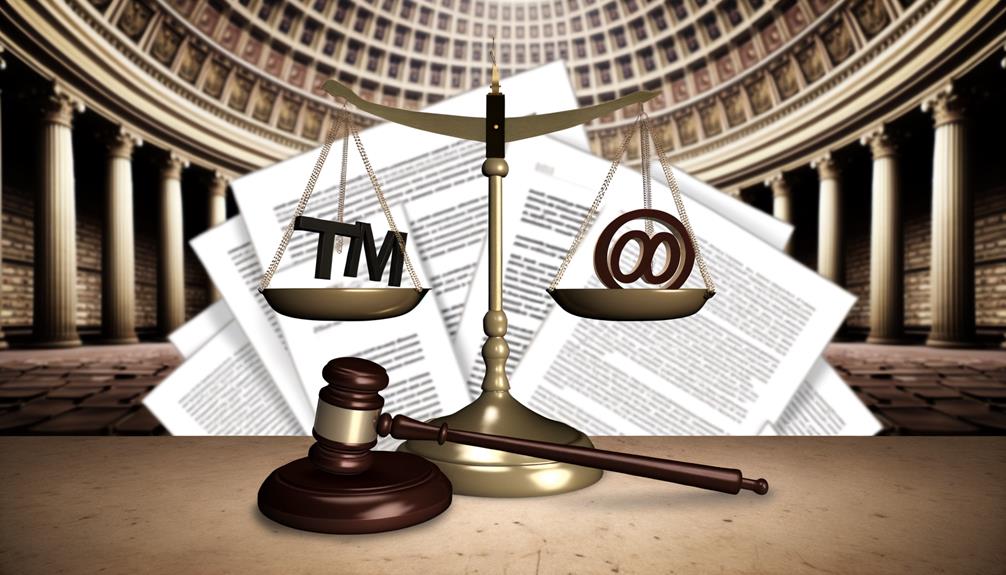What Is the Meaning of the TM Symbol for Your Brand?
The TM symbol stands for 'trademark' and signifies a claim of ownership over a brand or mark without the necessity of formal registration. It provides common law rights that offer protection through usage.
Legally, the TM symbol serves as constructive notice to potential infringers, enhancing brand identity and mitigating disputes. It contrasts with the registered trademark symbol, which denotes marks officially registered with trademark offices, affording stronger legal recourse.
Proper placement after the trademarked term is essential to uphold these protections. Exploring its detailed usage and implications can reveal deeper insights into brand protection strategies.

Key Takeaways
- The TM symbol represents a claim of ownership over a trademark.
- It signifies a brand's identity without requiring formal registration.
- Provides common law rights for brand protection and legal acknowledgment.
- Indicates to others that the mark is being claimed as a trademark.
- Helps in establishing and defending trademark rights against potential infringers.
Definition of the TM Symbol

The TM symbol, standing for 'trademark,' denotes that a word, phrase, logo, or design is being claimed by a business as its trademark without necessarily having registered it with a governmental trademark office. This designation serves as a public notice of the claimant's assertion of ownership rights over the mark in connection with specific goods or services.
Utilizing the TM symbol can help establish a brand and potentially provide common law rights, which may offer some level of protection against unauthorized use by others. Importantly, the TM symbol does not require formal registration, making it accessible for businesses to signal their proprietary interest in a mark while they may pursue formal registration or even if they choose not to register it at all.
Historical Background
Historical context reveals the origins and evolution of the TM symbol as a pivotal tool in the landscape of intellectual property rights. The TM symbol, short for 'trademark,' traces its roots back to ancient civilizations where merchants marked their goods to signify origin and quality.
This practice evolved through medieval guilds, which used marks to identify the craftsmanship of their members. In the modern era, the TM symbol emerged to denote unregistered trademarks, signifying claims of ownership without formal registration.
Its usage became more standardized with the advent of contemporary trademark law, providing a means for businesses to declare their proprietary rights and distinguish their goods or services in the marketplace. This historical progression underscores the TM symbol's enduring significance.
Legal Implications

Building on its historical significance, understanding the legal implications of the TM symbol is essential for thoroughly exploring intellectual property law.
The TM symbol denotes a claim of ownership over a trademark, signifying that the user asserts rights to a particular mark associated with goods. It does not, however, indicate that the trademark has been registered with any governmental authority. This distinction is important, as using the TM symbol can provide constructive notice to potential infringers, potentially deterring unauthorized use.
Moreover, the TM symbol offers some degree of common law protection, allowing the owner to enforce their rights in court, albeit with limitations compared to registered trademarks. Hence, the TM symbol is a crucial tool for brand protection and legal strategy.
TM Vs. Registered Trademark
While both the TM symbol and the registered trademark symbol (®) serve to protect intellectual property, they differ greatly in legal acknowledgment and enforcement.
The TM symbol indicates a claim to trademark rights, often used prior to formal registration. It provides common law protection but lacks the legal authority of a registered trademark.
Conversely, the ® symbol signifies a trademark that has been officially registered with the relevant governmental authority, such as the United States Patent and Trademark Office (USPTO). This registration confers nationwide protection and the exclusive right to use the mark in connection with the goods or services listed in the registration.
Therefore, the ® symbol offers stronger legal recourse against infringement compared to the TM symbol.
How to Use the TM Symbol

In using the TM symbol, it is essential to adhere to proper placement guidelines by positioning the symbol immediately after the trademarked term, typically in a superscript format.
Legal considerations mandate that while the TM symbol does not require formal registration, its use indicates a claim to common law trademark rights.
Ensuring accurate application of the TM symbol enhances brand protection and mitigates potential legal disputes.
Proper Placement Guidelines
The TM symbol should be placed immediately following the trademarked name, logo, or phrase, without any intervening spaces or punctuation. This precise positioning ensures clear association between the TM symbol and the trademarked element, reinforcing the assertion of trademark rights.
Whether the trademark appears in text, on packaging, or within advertising materials, consistent placement is essential. The TM symbol should be in the same font and size as the trademarked item to maintain uniformity and visibility.
For logos, the symbol is typically situated at the upper right-hand corner, but it can also appear at the lower right. Correct positioning not only conveys professionalism but also informs the public of the trademark claim, enhancing brand protection.
Legal Considerations
Understanding proper placement guidelines is just one aspect; compliance with legal considerations is equally crucial when using the TM symbol. The TM symbol, indicating an unregistered trademark, does not require formal registration. However, it must be used in a manner that accurately represents the trademark's applicability to the associated goods or services.
Misuse of the TM symbol can lead to allegations of deceptive practices or false advertising under trademark law. It is essential to make sure that the mark is distinctive and not likely to cause confusion with existing trademarks. Moreover, businesses should be vigilant in monitoring and enforcing their trademark rights to prevent unauthorized use.
Consulting with a trademark attorney is advisable for adherence to legal standards and effective trademark protection.
Benefits for Businesses
Utilizing the Tm symbol provides businesses with a strategic advantage in brand protection and intellectual property management. The Tm symbol signals a claim to trademark rights, even prior to formal registration, alerting competitors and consumers to a business's proprietary interest in a brand.
This early notice can deter potential infringement and facilitate legal recourse in case of unauthorized use. Additionally, the Tm symbol can enhance the perceived legitimacy and professionalism of a brand, fostering consumer trust and loyalty.
Common Misconceptions

Despite its widespread use, there are several common misconceptions regarding the legal implications and proper application of the Tm symbol.
To begin with, the Tm symbol does not confer any legal rights or protection; it merely indicates that a trademark claim is being asserted. Unlike the registered trademark symbol (®), which signifies a mark registered with the relevant governmental authority, Tm can be used without formal registration.
Next, some believe the Tm symbol is restricted to specific goods or services; however, it can be applied broadly across various categories.
Lastly, the Tm symbol does not offer international protection. Its recognition and effects vary by jurisdiction, underscoring the importance of understanding local trademark laws when using the symbol globally.
Conclusion
To sum up, the TM symbol serves as an important tool for businesses to indicate ownership of their trademarks, even without formal registration. Its historical roots and legal implications underscore its significance in protecting intellectual property rights.
Differentiating it from a registered trademark is essential for proper usage. Businesses benefit greatly from employing the TM symbol, although common misconceptions persist.
An understanding of its application can prevent unnecessary legal challenges and strengthen brand identity in the competitive marketplace.





